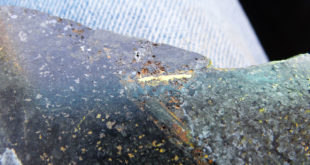Market comment:
What do you say about this last week?? With gold back below $280US, is it headed back to $260US?? With a war going on in Afghanistan? With a potential war brewing next door between Pakistan and India? With religious rioting in Nigeria and Indonesia? With the anthrax scare? With almost across-the-board US stock market quarterly earnings results that are abysmal? With corporate forecasts that are even worse? With Argentina on the brink of debt default?
Is the gold market behaving as a market responding to normal supply and demand forces, when the US mint can’t find enough planchets for gold coins? When the Japanese are buying ingots like crazy? When US coin suppliers are sold out?
This is a titanic struggle between the New Era economists who continue to say that earnings and dividends and such are no longer important, and the contrarians who look towards gold for asset enhancement and preservation, with a commodity that has been universally accepted as valuable for over 5,000 years. Don’t expect the New Era boys to go down without a fight! This is “Crash Season” after all. Lucent Technologies announced an $8.8 BILLION loss today. Brings to mind a quote from the old T.V. sitcom “WKRP in Cincinnati”: “As God is my witness, I thought turkeys could fly.” This last week the powers that be have been playing whack-a-mole with gold. The continuing burgeoning US money supply will be their undoing. How can the US dollar stay high when interest rates are so low? Short of a Bmovie anti-gravity device, it can’t.
According to the Friday, October 19th edition of the Wall Street Journal, EBay profit jumped 24% in the last quarter. Why would this darling of the New Economy do well? “Many analysts believe the company may actually thrive in an economic downturn as cost conscious buyers are drawn to the site and sellers use EBay to raise cash.”
Investing in Diamond Stocks
If you are getting sick and tired of watching the gold price whumped in the face of bullish gold market news you might want to take a closer look at the diamond scene. I’m not turning my back on gold, but I do believe a little defensive diversification doesn’t hurt.
I would argue that there are only 2 commodities that can ALWAYS be changed into cold hard cash in an emergency. One is gold, and the other is diamond. You just have to look around your local pawn shop to see this is so. You can sell diamonds in New York, New Haven or New Britain. Take a look at EBay’s website and see how many diamonds are on it. For just these reasons you might consider a defensive holding in diamonds as well as gold. Also, there are some interesting developments in Canada that you should know about. First off, I will need to give everyone a short geology lesson and a recap on the recent story in diamonds, particularly in Canada.
There are two kinds of diamond mines: hard-rock, and alluvial. There are numerous alluvial diamond mines around the world, extracting diamonds from gravel. Because diamond is relatively dense it can form placer deposits, in the same way that gold forms placers. Famous river bed deposits are found in Guinea, South Africa, Brazil, Venezuela, and Guyana. There are also marine terrace deposits – either on land or underwater. The only exploited marine diamond deposits lie along the west coast of southern Africa, in Namibia and South Africa. Marine deposits formed where diamond-bearing rivers entered the ocean. Diamonds were carried along the shoreline by wind and tide in a process called “longshore drift”. The constant pounding of the surf removed softer components, leaving the harder diamonds concentrated in beach gravels. Many of these deposits formed at a time when sea level was much lower than present, so a great deal of them are now drowned and have to be mined by dredging or vacuum equipment. The beach deposits were first found by geologist Hans Merensky in 1926, but it was many years before anyone decided to prospect the sea bottom and could figure out how to mine on a coastline so hostile to shipping it is called the “Skeleton Coast”. Sammy Collins, a Texan experienced in cable and undersea pipeline laying, was the first one to take a stab at it and ended up making a mint of money. His company, Marine Diamond Corporation, was bought up by De Beers in 1965.
The diamonds in alluvial deposits ultimately are sourced from the erosion of hard-rock deposits. Hard-rock diamond deposits are found on all continents except for Antarctica, though speculation is that they are there too. Diamonds have been found in three types of rock: kimberlite, lamproite and lamprophyre. Most of the world’s mines are in kimberlite, including the Ekati diamond mine in Canada, the Kimberley area mines in South Africa, and the famous Mirny and Udachnaya mines in Russia. The Argyle Mine in Australia is in lamproite. Diamonds have been found in several lamprophyre occurrences, but so far no commercial deposits have been found. These rock types are all of very deep origin, derived at depths in the Earth’s mantle (>200 km) sufficient for carbon to exist crystallized as diamond. You might not know it, but diamonds will burn if subjected to high heat. We all know that it gets hotter in the Earth the deeper you go, so how do diamonds survive? It’s because at extreme pressures very deep down the diamonds are stable. They can only be brought to surface through a type of volcanic eruption initiated deep in the mantle, and the molten kimberlite has to move extremely fast to surface to avoid getting the diamonds cooked up. It has been estimated that near the surface, the molten rock is moving at 3 times the speed of sound! (There haven’t been any eruptions in historic time, thank goodness). At surface, it solidifies almost instantaneously. If it got slowed down at any point on its ascent, under the lower pressure regime at shallow depths, the diamonds contained in it would be cooked to black graphite and we would have pencil leads instead of engagement ring stones. This is one of the reasons why not ALL kimberlites are diamond bearing. This is an important consideration. There have maybe been 5,000 kimberlite occurrences found worldwide. Of these, only about 1 in 10 are diamond-bearing, and of those 500 or so, only 50 or 60 have become mines. That doesn’t sound like good odds, but kimberlites usually occur in clusters of 5 or 6, and quite often if there is one high grade one, there is another or several within a kilometre or two. Geologists who specialize in diamond exploration also know several ways to forecast early on whether or not a particularly kimberlite or “field” – district in which kimberlites occur, is going to be a good bet. More about this in a moment. As a yardstick comparison, I’ve read that for every 1,200 occurrences of gold found, only one will be in sufficient quantity to be mined.
Kimberlite can occur in three different ways: in sills, in dykes or in pipes. Sills and dykes are very similar and can be thought of as cracks in the Earth which are filled in with kimberlite rock. These things are usually narrow, maybe a few metres in thickness, but can extend for 100s of metres to several kilometres. If they are vertical in orientation, they are called dykes; if horizontal, they are called sills. Dykes and sills solidified near the surface but never quite made it to there to cause an eruption. On the other hand, kimberlite pipes are the eroded remnants of old volcanic necks. They’re shaped like an ice cream cone, or a carrot – round in plan view on the surface and in cross section gradually tapering downward until merging into a dyke. Pipes can be anywhere from 50 to several hundred metres in diameter, and they can be many hundreds of metres in vertical extent. Pipes represent significant volume of contained kimberlite rock and can be mined by open pit methods using economies of scale. They are the most attractive type of kimberlite targets. Dykes have however been successfully mined both from surface and underground. The near flat-lying sills at Snap Lake in the Canadian Northwest Territories are slated to go into production in 5 years.
What controls the economics of a kimberlite is the value of each tonne of ore. This is controlled by the grade, which is usually expressed as carats per hundred tonnes; and the average dollar value per carat, which is assessed by valuers who specialize in gemmology. For instance, an average value per carat of $US200 would be considered very high, and is only attained by a very few mines. Values of $US10 are very low, and the pipe would have to be very high grade to be economic. Economic mines can vary anywhere from 20-500 carats per hundred tonnes.
Over the last hundred years the search for diamonds has become increasingly more technical, but not so much so that individuals can’t pull off tremendous discoveries for themselves. In 1940, John Thornburn Williamson, a Canadian geologist working in Tanzania, found an exceedingly rich kimberlite pipe by prospecting the African veldt with a small crew of native workers. The discovery made him the richest person in the British Empire.
In 1990, geologists Chuck Fipke and Dr. Stewart Blusson discovered the Lac de Gras kimberlite field in the Northwest Territories of Canada. The discovery came after 5 years of intermittent effort, much of it funded at the barest of bare bones level. Fipke and Blusson each personally hold 10% in the Ekati diamond mine, which is run by Australian mining house BHP. Ekati formally commenced production in October, 1998. Ekati currently produces 6% of world diamond production, and new economic kimberlites are still being found. A second mine, Diavik, is currently under construction and is scheduled now to be on stream in April, 2003. Diavik is a joint venture between Rio Tinto plc (60%) and Aber Diamond Corporation (40%). A third mine in the north, Snap Lake, was discovered by junior company Winspear Resources Ltd. and Aber in 1996. Winspear was taken over by De Beers last August. Snap Lake was scheduled to be up and running in 2004, but recently De Beers have pushed that back to 2006, citing soft demand for diamonds. Since De Beers controls a great deal of worldwide diamond supply, methinks they would be just as happy controlling them in the ground as in the vault. Many people are entirely unaware of Canadian diamonds, however they are certainly not a pipe dream (pardon the pun). The Canadian government estimates that the three mines will produce $US20 billion of gem-quality diamonds over the next 20 years, enough to rank Canada alongside South Africa for output, behind Botswana and Russia. Something to watch though is that many of the claim blocks staked in the early 1990’s rush at Lac de Gras are now coming open. It is not possible to hold ground more than 10 years unless you bring it to lease and can demonstrate a valuable mineral discovery. Companies that held ground for the last few years but lacked the funds to explore, now have to cut it loose, so expect a turnover in ownership and potentially some new discoveries.
Fipke and Blusson, and before them Williamson, used the same method to find their kimberlites – heavy indicator mineral tracing. Heavy indicator minerals are minerals which are almost exclusive to kimberlite – pyrope and eclogite garnet, chrome diopside, picroilmenite, magnesio-enstatite, and chrome spinel. The minerals are dense, fairly hard, and much more abundant than diamond in even the most diamond-rich kimberlite. They can be recovered by simple panning methods in streams. Williamson back in the 1930’s looked for the purple pyrope garnets and other minerals in dry stream beds and pans, following them upstream to the kimberlites.
In areas that have had glacial ice travel over them, any heavy mineral concentration in streams has been stripped away from the landscape, or buried beneath a thick veneer of glacial sediment which we call “till”. However, the situation is not as bleak for diamond exploration as it sounds. When glacial ice scrapes its way across the landscape it leaves gouge marks and scratches on the bedrock surface. These scratches always lie in the direction the ice travelled. Geologists measure the scratches to trace the path of the glacier. If you look at a map of an area like Minnesota or northern Ontario you will see that many of the lakes are aligned in the same direction. This is because of the gouging action of the passage of glacial ice. When a glacier travels over kimberlite it will incorporate some of the rock in the basal ice at the bottom of the glacier and then smear it out in the direction the ice travels. Geologists collect samples of glacial till, and then in a simple procedure recover and count up the indicator minerals. As the glacier moves in the “down ice” direction, the smear pattern for the kimberlite decreases in intensity because bits of the kimberlite are dropping out of the ice, and bits of other rock types are constantly getting picked up in a dilution effect. So – if you’re still with me -if you take samples systematically across the countryside and get a hit of a few kimberlite indicator minerals, and if you then sample in the direction you believe the ice came from, the indicator counts should increase, leading you eventually to the kimberlite. It is tedious work, but for Fipke and Blusson it paid off most handsomely.
Kimberlite is typically a magnetic rock, and using a device called a magnetometer, they can be quickly located using an aircraft. Trouble is, other rock types are magnetic too. This calls for the integration of airborne geophysical surveys with glacial till sampling. Typically, the geologist will sample in the down-ice side of his magnetic targets. If the samples yield large numbers of indicators you’ve found your pipe, if none, the rock is something else.
One final thing you should know, and this is crucial to understanding why at an early stage you can predict if diamonds are going to be present. As well as being what we call “pathfinder” minerals of kimberlite, indicator minerals can be used to forecast grade. Back in the late 1960’s, geologists started to examine and chemically analyse the tiny indicator minerals that were found encapsulated within diamonds. Most people would regard these simply as “flaws” in stones. These “inclusions” had been incorporated into the diamond as it grew 200 kilometres down. It wasn’t until 1971, when enough analyses had been done that geologists began to realize that the “inclusion” minerals had unique chemical compositions. When indicator minerals recovered from kimberlite were analysed from producing mines and compared, it was found that the mines that had the best diamond grades had the greatest number of these special unique chemical compositions, or “inclusion type” compositions. Kimberlites with none were generally barren. This was a quantum leap in diamond exploration, because if you chemically analysed your indicator minerals from the piece of moose pasture you recovered them from, and they were of inclusion-type composition, then there was a pretty good chance that they came from high-grade diamond-bearing kimberlite.
The method is not fool prove, but is reliable most of the time. This technique has allowed geologists to prioritize their search areas. Back in 1975, two geologists, Stephens and Dawson, categorized all the various garnet types in kimberlite into a 12-fold classification. Chrome-rich sub-calcic garnets went into the “G10″ classification. These are widely regarded as one of the best types of garnets to have. I include this just in case you see the term “G10″ bandied about in a press release.
After the Bre-X fraud, and virtual collapse of the junior exploration scene, many Canadian companies which formerly were exploring all over the world, decided to pull in their horns and concentrate on domestic projects. Over the last three or four years a number of companies have been quietly working away in their diamond searches. They haven’t received a lot of press because frankly, they weren’t doing much and they weren’t generating any sexy results. That all seems to be changing rapidly. The new play is in northern Quebec, the province that sits east of Hudson Bay. Leader of the pack is Majescor Resources, a company listed on the CDNX. Majescor controls over 3,000 square kilometres in two project areas; Wemindji, which sits on the coast of James Bay; and Portage, which lies in the Otish Mountains and straddles the Eastmain River. In June this year, diamond miner BHP made a deal to earn up to a 56% interest in the Portage property by effectively paying for all work performed on the property, reimbursing Majescor’s staking costs of $260,000 and transferring 52,000 hectares of its own ground in the area to Majescor. That ground would form part of the deal, and it would bring the total property covered by the deal to nearly 200,000 hectares.
Ultimately, BHP must complete a 200 tonne mini-bulk sample within the next four years, or it will forfeit any interest in the property. At that stage, BHP would have a 40 % stake in the play, and its interest would grow to the full 56% share only by completing a bulk sample program, a feasibility study and arranging for financing to build a mine. BHP has already committed itself to a $1.1 million exploration and acquisition program for the remainder of the year. BHP has conducted more mineral sampling on the property, and carried out an airborne geophysical survey over the ground.
Back at Wemindji, work this last summer concentrated on previously found anomalous concentrations of indicator minerals. Over 9,000 indicators were found in a single sample collected in 2000. Summer 2001 sampling yielded counts as high as 7,611. These are very impressive results. A high resolution airborne geophysical survey has also been completed. Drills should be turning in about two weeks.
Back in March, Jacques Letendre, Majescor’s President, showed me some fragments of kimberlite rock recovered from till samples at Wemindji. The fragments were angular and around 2 cm (an inch or so) across, and my guess is that they could have come from frost heave. They certainly didn’t look like they had been transported by ice any significant distance. In August this year, they found a second site with kimberlite fragments, 10 km away from the first site. I first met Jacques in Russia in 1995, at an international diamond conference. He was running diamond exploration for Golden Star Resources at the time and was instrumental in the discovery of the first kimberlite in Guyana. Jacques knows his stuff, and began his career in diamond exploration with De Beers. They have some indicator mineral chemistry plots on their website. It’s not the whole picture, but to someone versed in interpretation of these plots they look pretty good. Majescor was trying to do a deal and morph into a high tech company so they were halted up until February of this year. Luckily the deal didn’t happen. Take a look at their website. http://www.majescor.com
Ashton Mining of Canada Ltd. holds another huge land package in the Otish Mts. They are partnered up 50% with SOQUEM Inc., a wholly-owned subsidiary of SGF Minerals Inc., which is a subsidiary of the Société Générale de Financement du Québec, a government entity. Ashton and SOQUEM together control over 180,000 hectares of ground. On October 16th, Ashton announced the discovery of their second kimberlite from the recently completed drill programme. Their first discovery was announced on September 21st, so the news is coming thick and fast. The next news will be microdiamond counts from the recovered kimberlite drill core. Microdiamonds are small, non-commercial stones which are typically more numerous than cutable stones in a diamond-bearing kimberlite. Because they are more numerous, they are a proxy for gem diamond sampling – if large numbers of micros show up in samples the expectation is high for the presence of commercial-sized stones. Ashton is involved in other diamond plays elsewhere in Canada too. You can follow the fortunes of Ashton at http://www.ashton.ca
For the French speakers, there is a report (MB 99-35) available from the Quebec Ministry of Natural Resources entitled “Kimberlites, linéaments et rifts crustaux au Québec”. The reason I mention this is to show that there is information out there independent of the companies involved. Government geologist James Moorhead has written a report on diamonds in Quebec. A summary can be found at: http://www.apq-inc.qc.ca/francais/cong99/99_09.htm (first part in French, English follows).
Whatever transpires in Quebec, this is certainly a play to watch! It was front page news in the Northern Miner newspaper last week. For those who may be looking for a company that does not have all their exploration plays in far flung places like Malaysia, Indonesia, Oman, or Tanzania, with significant Muslim populations, Canada, the USA, Australia, and Latin America may be looking good again.
*****
Straight Talk on Mining is provided for information purposes only. Nothing herein is to be construed as a recommendation to buy or to sell any particular security or financial instrument. Nothing herein is to be construed as a recommendation to engage in any particular investment strategy or trading strategy.
The investments discussed herein may be unsuitable for investors depending on their specific investment objectives, financial situation, and risk tolerance. Private investors should obtain the advice of a qualified financial advisor before entering into any transaction.
Straight Talk on Mining is based on information that is generally available to the public. The sources used are believed to be reliable, but because the information and data that they provide are beyond our control, no representation is made that it is complete or accurate. Staff of Straight Talk on Mining may or may not be invested in the equities mentioned. References to other publications and direct links to external Internet sites are sometimes given. The inclusion of any publication, organization or Internet site herein does not imply any endorsement. Straight Talk on Mining has no control over the content of any Internet site that you may reach through links that are provided, nor can their truth, accuracy, or completeness be vouched for.
Straight Talk on Mining is not a financial services company nor is it affiliated with any financial service company in any jurisdiction.
The author/publisher, Dr. Keith M. Barron, is not a qualified financial advisor and is not acting as such in this publication. The accuracy of any legal term or definitions used herein should be verified with your legal advisor or the appropriate government agency.
 Straight Talk On Mining Insights on mining from economic geologist Dr. Keith Barron.
Straight Talk On Mining Insights on mining from economic geologist Dr. Keith Barron.




